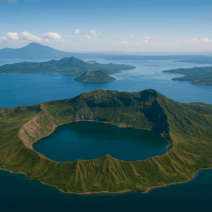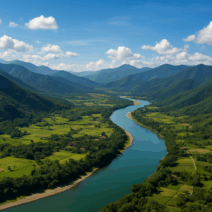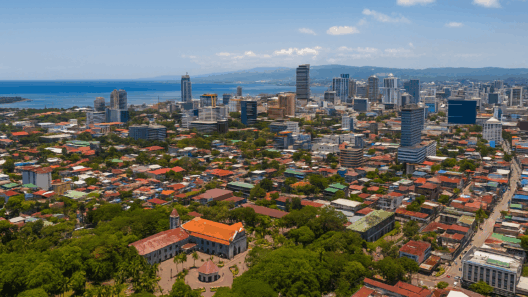El Nido is one of the Philippines’ most striking destinations, known for its emerald lagoons, sharp limestone cliffs, white-sand beaches, and scattered islands stretching across Bacuit Bay.
Located in northern Palawan, it offers an atmosphere that feels both adventurous and peaceful, with landscapes that appear almost unreal in their beauty. Travelers come for island hopping, snorkeling, kayaking, and quiet moments among nature. This guide explores El Nido in detail, helping visitors navigate its islands, activities, accommodations, and essential travel logistics.
Understanding El Nido
El Nido serves as the gateway to the Bacuit Archipelago, a group of islands filled with lagoons, secluded beaches, caves, reefs, and dramatic rock formations. Many of the landscapes are shaped by limestone karst formations similar to those in Coron, but El Nido’s features are distinguished by their softer curves, hidden coves, and wide-scale expanses that stretch far across the bay.
The town serves as the central hub for accommodations, restaurants, and tour operators. Island-hopping tours form the backbone of travel in El Nido and follow structured routes labeled Tour A, B, C, and D. These tours keep the area organized and help preserve its natural beauty. The climate stays tropical year-round, with dry months offering the clearest visibility for water activities.
Big Lagoon
Big Lagoon is one of El Nido’s most iconic attractions. Boats approach through towering cliffs that open into a wide lagoon of shimmering blues and greens. The water is calm, and kayakers glide across the lagoon to explore corners where light reflects softly off the limestone walls. The lagoon’s depth and clarity create a dynamic environment where the water shifts in color depending on the angle of sunlight. Big Lagoon sets the tone for El Nido’s dramatic natural scenery.
Small Lagoon
Small Lagoon offers a more intimate atmosphere, with narrow passages leading into quiet pools of calm water. Kayaking is the best way to enter and explore its interior. The cliffs rise close and high, creating a sense of enclosure that enhances the lagoon’s peaceful charm. Travelers enjoy navigating through small openings, discovering shaded corners, and observing the interplay of light on the limestone.
Secret Lagoon
Secret Lagoon features a concealed opening in the limestone that leads into a circular pool. Visitors often crouch through a small entryway before reaching the hidden interior. The lagoon’s quiet, enclosed atmosphere contrasts with the open spaces found elsewhere in the islands. Its simplicity and tucked-away setting make it feel like a natural hideout discovered by accident.
Shimizu Island
Shimizu Island combines limestone formations with small stretches of beach ideal for picnics and swimming. Snorkelers explore coral gardens that surround the island, while calm areas near the shore allow beginners to enjoy marine life. The island often serves as a lunch stop during tours, giving travelers time to relax and appreciate the scenery from the sand.
Seven Commandos Beach
Seven Commandos Beach is a long strip of white sand backed by palm trees and limestone cliffs. The water is clear and welcoming, making it ideal for swimming and relaxing. Travelers enjoy the open beach space, gentle waves, and refreshment stalls that offer fresh coconut and simple snacks. The beach’s broad layout creates a bright and lively atmosphere.
Hidden Beach
Hidden Beach lies behind limestone walls, with boats anchoring outside the cove while travelers swim or walk through shallow water to reach the shore. The approach creates a sense of anticipation as the small pocket of white sand and calm water gradually comes into view. The cliffs create natural shelter, making the beach feel private and untouched.
Secret Beach
Secret Beach is accessed by swimming through a small opening in the limestone during calm conditions. Inside, a sandy cove awaits, enclosed by towering walls. The beach feels mysterious due to its hidden entrance and stillness. Its dramatic setting captures El Nido’s character as a place where nature reveals itself gradually through exploration.
Matinloc Shrine
Matinloc Shrine sits among the cliffs of Matinloc Island and features a viewing area that overlooks the sea. The shrine’s structure and surroundings create a tranquil environment where visitors appreciate both cultural history and panoramic seascapes. The cliffs nearby offer rugged viewpoints ideal for photography.
Helicopter Island
Shaped like a helicopter from certain angles, this island has a long stretch of white-sand beach and a backdrop of towering cliffs. Snorkeling is popular here due to the shallow reefs that lie close to shore. The island’s length and open layout make it ideal for long beach walks and leisurely swims.
Snake Island
Snake Island features a winding sandbar that stretches across turquoise water, connecting a small island to a larger landmass. During low tide, travelers walk along the curved sandbar while surrounded by clear water on both sides. The island’s viewpoint offers sweeping vistas of nearby islands and the sandbar’s shape.
Cudugnon Cave
Cudugnon Cave is accessed through a narrow opening that leads into a chamber with high ceilings and natural rock formations. The cave holds archaeological significance, as ancient artifacts were once discovered here. The interior is cool and shaded, offering a contrast to the bright beaches and lagoons.
Cathedral Cave
Cathedral Cave is named for its high ceilings and vertical rock formations that give the impression of a grand stone hall. Boats pass close to the cave’s entrance, allowing visitors to appreciate its scale. The dramatic rock formations create interesting patterns of light and shadow.
Pinagbuyutan Island
Pinagbuyutan Island is known for its tall limestone cliffs that rise dramatically from the sea. The island has a peaceful beach area with powdery sand and clear water. Its distinctive shape makes it one of Bacuit Bay’s most recognizable landscapes, and its quiet atmosphere appeals to visitors seeking calmer stops.
Lagen Island and Miniloc Island
Lagen Island and Miniloc Island host eco-resorts that blend natural scenery with thoughtful design. These islands offer private access to lagoons, beaches, and forest areas. While generally visited by staying guests, the islands reflect El Nido’s commitment to sustainable and low-impact tourism.
Suggested Itinerary for Three to Five Days
El Nido’s attractions fit naturally into a multi-day island-hopping and adventure itinerary.
Day 1: Town and Beach
Explore El Nido Town, visit nearby beaches, and enjoy local cafés. Prepare for island tours by arranging bookings and reviewing options.
Day 2: Tour A Highlights
Spend the day exploring Big Lagoon, Small Lagoon, Secret Lagoon, and Seven Commandos Beach. Enjoy swimming, kayaking, and snorkeling.
Day 3: Tour C Adventure
Visit Hidden Beach, Secret Beach, Matinloc Shrine, and Helicopter Island. Expect more snorkeling, swimming, and scenic boat rides.
Day 4: Tour B or D
Explore Snake Island, Cudugnon Cave, and Cathedral Cave. Enjoy quieter islands and long sandbars.
Day 5: Free Exploration
Relax on nearby beaches, revisit favorite spots, or choose a specialty activity such as diving or private island hopping.
Where to Stay in El Nido
El Nido offers accommodations that range from rustic beachfront huts to high-end eco-resorts. Travelers choose areas based on their preferred atmosphere and proximity to boat tours.
El Nido Town
Staying in town provides access to restaurants, bars, markets, and tour operators. The area is lively and convenient for travelers who enjoy being close to amenities.
Corong-Corong
Corong-Corong offers quieter accommodations along a scenic bay where sunsets are particularly striking. Stays here feel more relaxed and intimate.
Lio Estate
Lio Estate features sustainable resorts, wide beaches, and landscaped areas ideal for slow walks. The environment is peaceful and well-maintained.
Island Resorts
Exclusive island resorts on Miniloc, Lagen, and Pangulasian provide private access to coves and lagoons. These stays suit travelers seeking privacy and comfort.
Transportation Tips
El Nido’s geography makes transportation simple once travelers understand the main options.
Boats
Boats serve as the primary mode for island tours. Operators handle routes, equipment, and safety briefings.
Tricycles
Tricycles are common for short distances between town, beaches, and accommodations.
Vans
Vans transfer travelers between Puerto Princesa and El Nido, covering the scenic road that connects northern and central Palawan.
Motorbike Rentals
Motorbike rentals allow exploration of beaches and viewpoints along the mainland. Riders appreciate the freedom to discover new areas at their own pace.
Practical Travel Tips
Simple preparations help visitors enjoy El Nido’s climate, terrain, and water activities.
Weather
Light clothing, sun protection, and waterproof dry bags are essential. Sudden showers can occur, especially during boat tours.
Safety
El Nido is safe and welcoming. Life vests are required during tours, and boat crews are experienced in navigating island passages.
Money
Cash is useful for small shops, food stalls, and tricycles. ATMs are available but may be inconsistent during peak seasons.
Final Thoughts
El Nido’s mix of lagoons, cliffs, beaches, and quiet islands creates a destination that feels cinematic and serene. Its landscapes invite exploration through kayaking, swimming, snorkeling, and thoughtful wandering among natural spaces. The town’s simple charm and the bay’s dramatic scenery combine to create a destination that stays with travelers long after they leave. El Nido remains one of the Philippines’ most beloved places for adventure and peaceful reflection.





